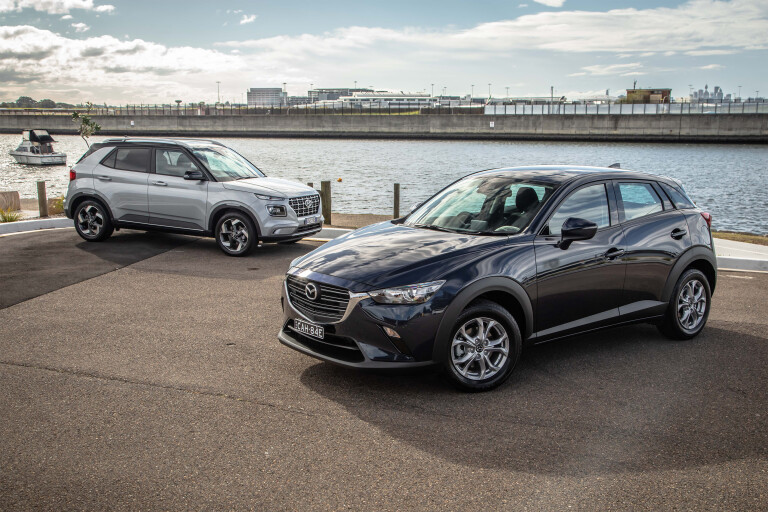
This is a battle between the old and the new. Mazda has done its thing with the CX-3 for a long time now, sharpening the saw, keeping things going with little fanfare but still plenty of sales, comfortably winning its segment in May.
Put together third and fourth place in the segment – from those automotive minnows Toyota and Volkswagen – and the Mazda number is still higher. Only Kia got anywhere near it with the Stonic, but it was still more than the Ford Puma’s 426 sales behind.
Why am I throwing all these numbers at you? Because there’s an important one – the CX-3 has been around in its current form for almost seven years, which in car terms is phenomenally old. But it doesn’t look it. It still looks fresh and – obviously – buyers agree.

It’s been a while since I drove one of these so it has been like meeting an old friend for coffee, catching up, seeing what’s new. When the changes Mazda make are sometimes so small, so detail-obsessive, sometimes it’s actually more like catching up with an old patient who hasn’t been in for a skin cancer check for a while.
Trailing the CX-3 with just over 500 sales – or a couple of better sales guys short of a third of CX-3 sales – is the Hyundai Venue. The Venue is Hyundai’s long-awaited entry into the light SUV segment and now stands as Hyundai’s cheapest car after the welcome departure (for us, anyway) of the old soldier Accent.
The Venue rides on a newer platform but is smaller in every external physical dimension compared to the Mazda, yet somehow manages to be bigger inside.
Pricing and Features

The Maxx Sport is the second tier of the CX-3’s extensive range, although some recent pruning of all-wheel-drive variants has brought the number of choices somewhat under control. Priced at $27,640 before on-roads, it’s not exactly loaded with fun but has one of the more complete safety packages in the class. Which is impressive given its age.
You get 16-inch alloys, a six-speaker stereo, climate control, reversing camera, keyless entry and start, rear parking sensors, sat-nav, auto wipers and headlights (still halogen, I’m afraid), leather shifter and steering wheel, folding power door mirrors and a space-saver spare.
The tired-looking version of MZD Connect (aka “the old one”) powers the 7.0-inch touchscreen, a rarity now in the Mazda range as the company ditches fondle slabs for rotary dial control only. It’s looking a bit pixelly and the hardware is a bit slow, but it does have Apple CarPlay and Android Auto and yes, it’s still better than anything Toyota dishes up.

On the safety front, the CX-3 Maxx Sport has six airbags, ABS, stability and traction controls, forward AEB (4km/h-80km/h) with pedestrian detection and reverse AEB (2km/h-8km/h), reverse cross-traffic alert and blind-spot warning. Those last two are additions over the Neo Sport and compared to the Hyundai, the main extra is the rear AEB that works in concert with the reverse cross-traffic alert.
The CX-3 carries a five star ANCAP rating from six years ago. I’m not entirely sure what it would get now – mostly because ANCAP has wild, mad moments and delivers surprises – but five stars would be a stretch without a centre front airbag.
You can tell the Hyundai is a much newer car just by looking at it. Whereas the CX-3 landed when cars were a bit samey (and it, therefore, stood out), the Venue is bold, blocky and Minecraft-inspired 8-bit.
I’m a fan, obviously because it’s good to see some fun ideas on a car like this. Buyers are conservative at this level so having a laugh doesn’t always work well. The car has a consistent design theme in the little details and it looks great.
Buyers are conservative at this level so having a laugh doesn’t always work well. The car has a consistent design theme in the little details and it looks great.
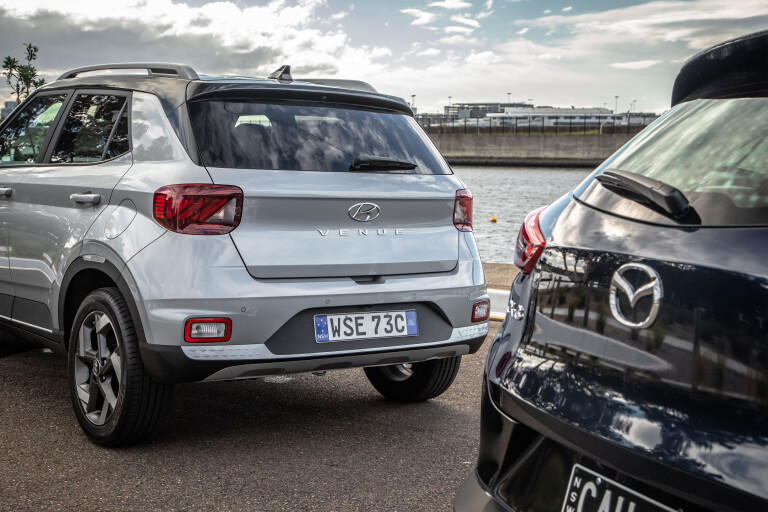
The Venue Elite is priced about the same as the Maxx Sport, but is the top of a three-car range. The Venue never finds the lofty heights of the mid-$40k mark like the CX-3, but makes do without things like all-wheel drive. But the Maxx Sport is a direct competitor and is priced that way.
For $26,740 – $900 cheaper than the Mazda – the Elite has 17-inch alloys, 8.0-inch touchscreen, six-speaker stereo, climate control, reversing camera, keyless entry and start, cruise control, sat-nav, auto headlights, auto high beam, power windows and mirrors and a space-saver spare.
It comes with six airbags, ABS, stability and traction controls, forward AEB with pedestrian detection, forward collision warning, reversing camera, lane keep assist, driver attention detection, blind-spot monitoring and rear cross-traffic alert. Along with two ISOFIX and three top-tether anchors.
The Venue scored four ANCAP stars in September 2019. It lost a star owing to its less advanced type of AEB but the forward AEB does work at up to 180km/h for other vehicles and up to 60km/h for pedestrians (day and night) and cyclists (day).
Comfort and Space

The CX-3’s boot is a very small 264 litres. Well, the litres are standard, but the boot has only about 70 per cent of what others in the segment have. It’s comprehensively out-litred by the Venue, Kia Stonic, and smashed by the Volkswagen T-Cross with its sliding rear seat.
Obviously, boot space isn’t a huge consideration among buyers because, as I’ve already said, the CX-3 beats them all in the sales race. If you fold down the rear seats, available space rises to 1174 litres.
Similar could be said for the rear seat accommodation. Despite the 3 in its name, the CX-3 is based on the small and perfectly-formed Mazda2, a car I like very much because I’ve never had to ride in the rear seat.
I’ve once spent time in the back of a CX-3 behind my wife (for science, you see) who is 174cm tall and I was not very comfortable. My knees were very buried in the seatback but there was some relief for my feet, with enough space to stretch my toes under the seat.
Harking back to a simpler time, the CX-3 has just one USB port and no rear air vents.

The Venue has a better rear seat, with space enough for me behind my driving position – I’m a hardly lofty 180cm – and a couple of inches clearance to the roof. My head does feel a little close to the C-pillar but given most rear-seat occupants are going to be kids (at least I hope so), that shouldn’t be an issue.
Knee and legroom are better in the Venue and I was going to say something clever like, “But the Venue has a longer wheelbase,” except it doesn’t. So the CX-3’s packaging is clearly sub-optimal compared to the Hyundai.
Thing is, the CX-3 has a centre armrest and cupholders whereas the Venue’s rear seat is a bit grim for further amenities. So while the Hyundai is more spacious, the CX-3 tries to soften the blow of its tight confines with some useful accoutrements.
At 355 litres, the Venue’s boot is rather generous and isn’t much short of the larger Kona. The boot’s false floor can be left at loading-lip height or you can slide out and re-insert it in a lower position to liberate the full capacity.
For some reason, Hyundai doesn’t quote a seats-down cargo capacity, but it’s likely to be in the order of 900-1000 litres. With the seats folded, the space doesn’t have the huge step of some cars in the class and neither does the CX-3.
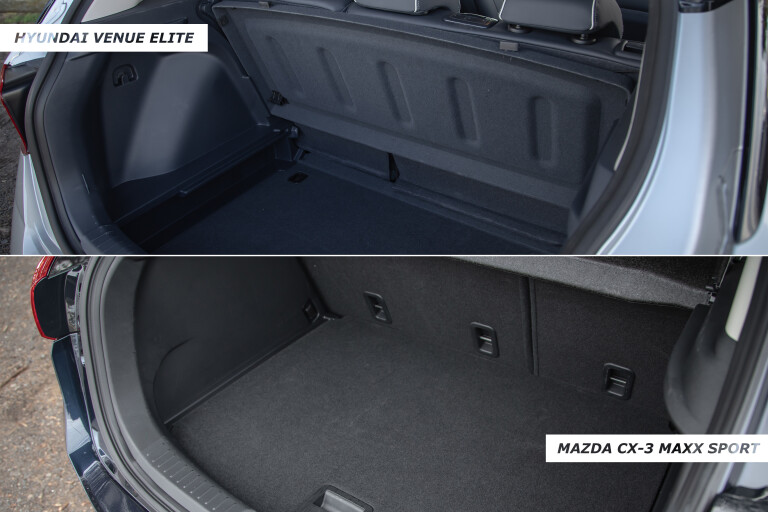
Both cabins are quite pleasant but have quite different approaches to design. The Mazda’s is very conventional but definitely going for classy.
Muted tones, circular air vents but reasonably large expanses of blank space. Large for a car this small, anyway. Both feature sensible cloth interiors with leather or leather-like shifter and steering wheels and modestly-sized screens that fit the size of the cabin.
I’m a big fan of the big, simple to use knobs, dials and physical switches in both cars, especially the Hyundai.
The CX-3’s cabin, however, is darker. The slimmer glassline contributes to the rather dashing looks but does nothing to lighten the mood inside.
Hyundai counters with a more upright glass box plonked on the body that lets in heaps of light and the pale grey of the trim as well as the deep navy blue and light grey of the dash and console architectures – along with a lighter headliner – ensure the Venue feels bigger and more upright, contributing to the SUV vibe.
While the Hyundai is more spacious, the CX-3 tries to soften the blow of its tight confines with some useful accoutrements.
On the Road
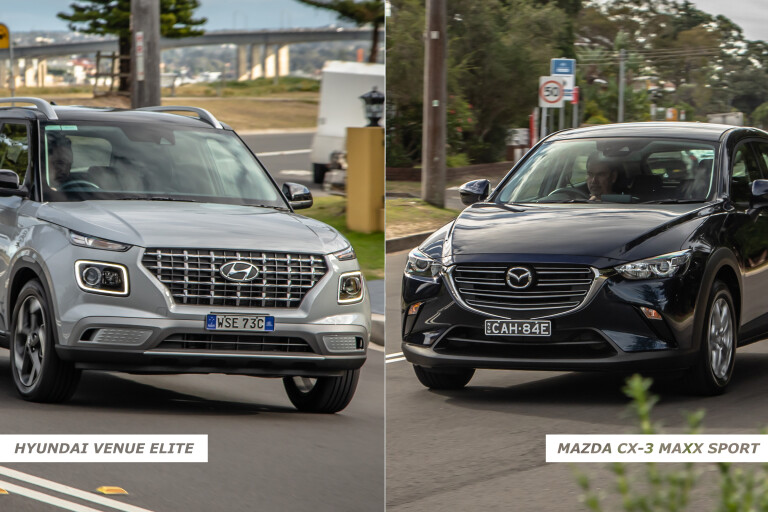
Mazda’s 2.0-litre four-cylinder SkyActiv engine is pretty good here in the CX-3, the company obviously deciding the 2’s 1.5-litre was not going to be up to the job. It kind of explains part of the price difference between the 2 and the CX-3.
For your accelerating and cruising pleasure, the Mazda conjures up 110kW at 6000rpm and 195Nm at 2800rpm, which isn’t bad at all. Added to that you’ve got yourself a six-speed automatic transmission as Mazda has so far resisted the cost-cutting urge to go CVT.
Over at Hyundai, the company has fitted the familiar 1.6-litre four-cylinder that has been around for a while. The Venue may be slightly lighter, but there’s a decent gap down to the power figure – 90kW at 6300rpm – and a bigger gap down to the torque number of 151Nm at 4850rpm.
The weight difference is just 50kg, so the gap is not bridged by lightness. Like the CX-3, the transmission is a six-speed torque converter automatic, although one wonders if that is long for this world given the Kona has fallen to the new Hyundai CVT (which honestly is pretty good).
The Mazda feels quicker because it is, dispatching the 0-100km/h run in around nine seconds while the Venue takes another two or so seconds. Around town it’s not much of an issue, of course, but the overtaking performance of the CX-3 is superior as is its ability to take a gap in traffic.

What I quite like about the Venue is the unexpectedly aggressive take-up of the transmission. I mean, it’s not going to snap your neck, but it responds more eagerly than I would have expected so it really feels like the calibration is set for darting about town. And dart you can because, like the CX-3, it’s quite light, rolls on a good chunk of rubber and has really good steering. I quite enjoyed scything about the place in it as it does feel a little more agile than the CX-3.
The key word here is feel, though, because there’s not much to complain about in the Mazda. I’ve always really liked the way the CX-3 goes, with good responses from the throttle and gearbox and plenty of torque to pull the reasonably light body along, something Mazda has worked very hard at achieving with a slightly bigger car.
The power steering has improved steadily over the years and gives useful feedback as you pound around town, is quick enough to react when you need to do something fast and also makes it a doddle to park. Although the reversing camera is pretty iffy, the reversing sensors are not, so it works out okay.
They’re both terrific city cars, which you’ll probably gather is where they spend most of their time in most cases. The CX-3 has long been a good tourer, despite a little bit of road noise at speed, so that’s an easy tick. The Venue acquitted itself very nicely on the freeway, too.
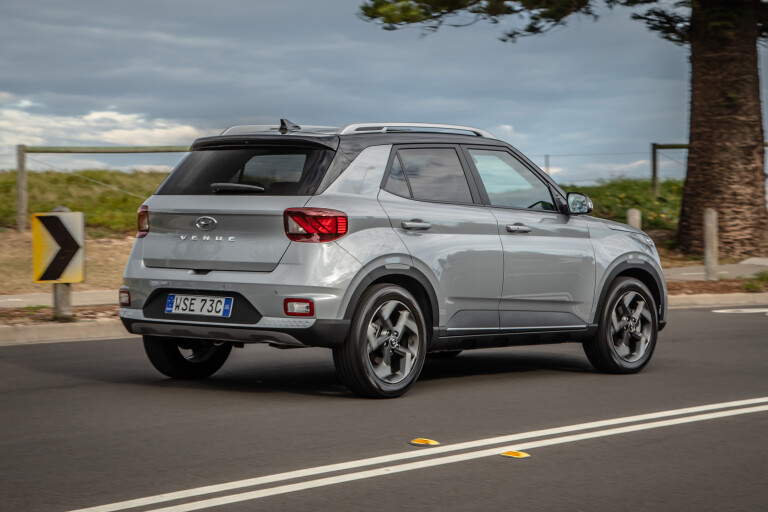
Amusingly, the Venue comes with traction programs on top of the three drive programs – Snow, Mud and Sand, none of which I would imagine too many customers test to any great degree. If it’s half as good as Peugeot’s similar system on its front-wheel-drive cars, it’d be great. Mazda makes do with a Sport mode that isn’t all that interesting.
When it comes down to fuel, the Hyundai has the edge. During the week I had it I managed 7.9L/100km in mostly city driving, which is better than when I last drove it, stacking up well against the 7.6L/100km combined figure. Mazda’s official combined cycle figure is an unlikely 6.3L/100km.
I’ve never got anywhere near that over the years and this time was no exception, with a 8.1L/100km number. Blame m’colleague Curt for that, he had the car for most of the time. And it is that little bit more fun to drive, so it’s easily forgiven.
What’s not so easily forgiven are the very ordinary headlights on the Venue. They’re quite yellow and a bit of a throwback in this age of LED everything.
Ownership
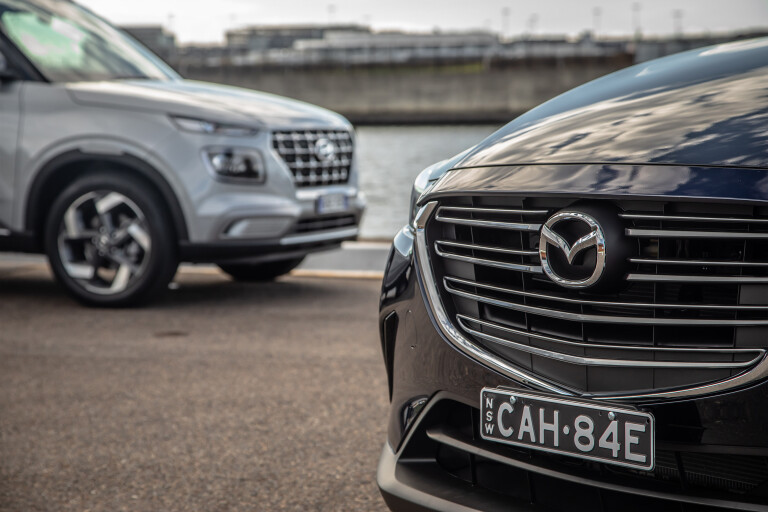
Both Mazda and Hyundai offer five-year, unlimited-kilometre warranties, with Mazda fronting you five years of roadside assist. Hyundai offers you an extension of 12 months on the roadside assist for up to ten years as long as you keep servicing with a dealer.
You need to return to the dealer every 12 months or 15,000km and all Hyundais carry a lifetime service plan, meaning you'll know what pretty much any service is going to cost you for the life of the vehicle.
The first five years costs $1575, for an average of $315 a year, which is not bad going and stacks up well against the CX-3.
You see, Mazda expects to see you every 12 months or 10,000km, which is starting to look a bit rich in this segment when the engine doesn’t have a turbo bolted in.
Service prices alternate between $331 and $391 for the first five years, costing $1775 over five years and averaging out at $355. Yeah, okay, it’s $40 but if you do more than 10,000km per year but less than 15,000km, it’s going to work out more again.
VERDICT

The CX-3’s staying power is remarkable but it’s not like it’s an identical car to the one we first drove all those years ago. Years of tiny refinements have kept it in the game, without any great fanfare or splashy PR or marketing campaigns yelling about “the all-new Mazda CX-3” that actually just had a new damper valve and a power steering tweak.
You have to respect the confidence of the company to just keep working at the car. It has taken almost this long for the CX-3 to start feeling a little old, though, particularly the cabin technology. But it’s still great to drive and comes with an impressive safety package.
Hyundai’s venue was extremely late to the party, so late it arrived around the same time as a competing Volkswagen. And that’s saying something. The Elite is probably a bit much for most tastes because what it has over the Active is mostly frippery, but for the money provides a compelling proposition against the CX-3.
It’s not as powerful and therefore not as quick but it drives really nicely, has lots of stuff and has more cargo and occupant space. And it’s cheaper to buy and own.
Like the CX-9 versus Santa Fe, it’s a close one. Neither delivers anything that makes you slap your forehead (people do that right?) and say, “Of course! This is the car for me!” This one is going to come down – again – to whether you want a particular badge or visual aesthetic.
For me, the Venue just makes it through the gate because I just liked it a bit more. That could be something tremendously shallow like the fact the Venue is newer and shinier which, again, shows how close is the battle. And for Mazda to keep the CX-3 in the game so successfully for so long, it must have been ahead of its time.
2021 Hyundai Venue Elite vs Mazda CX-3 Maxx Sport specifications
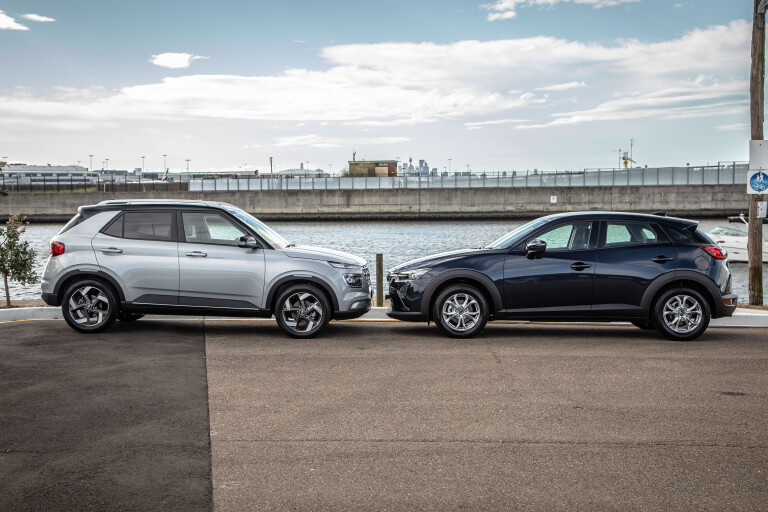
| Hyundai Venue Elite | Mazda CX-3 Maxx Sport | |
| Body | five-door compact SUV | |
| Drive | FWD | |
| Engine | 1.6-litre four-cylinder | 2.0-litre four-cylinder |
| Transmission | six-speed automatic | |
| Power | 90kW @ 6300rpm | 110kW @ 6000rpm |
| Torque | 151Nm @ 4850rpm | 195Nm @ 2800rpm |
| Bore/stroke | 77.0mm x 85.4mm | 83.5mm x 91.2mm |
| Compression | 10.5 : 1.0 | 13.0 : 1.0 |
| 0-100km/h | 11 sec (est) | 9 sec (est) |
| Fuel consumption | 7.2L/100km (combined) | 6.3L/100km (combined) |
| Weight | 1225kg | 1297kg |
| Suspension | MacPherson strut (front); torsion beam (rear) | |
| L/W/h | 4040/1770/1592mm | 4275/1765/1535mm |
| Wheelbase | 2520mm | 2570mm |
| Brakes | 280mm ventilated disc (front); 262mm solid disc (rear) | 280mm ventilated disc (front); 265mm solid disc (rear) |
| Tyres | 205/55 R17 Nexen | 215/50 R16 |
| Wheels | 17-inch alloy wheels (space-saver spare) | 16-inch alloy wheels (space-saver spare) |
| Price | $26,740 + ORC | $27,640 + ORC |
NOTE: On mobile phones, the above table is best viewed in 'landscape' view.



COMMENTS